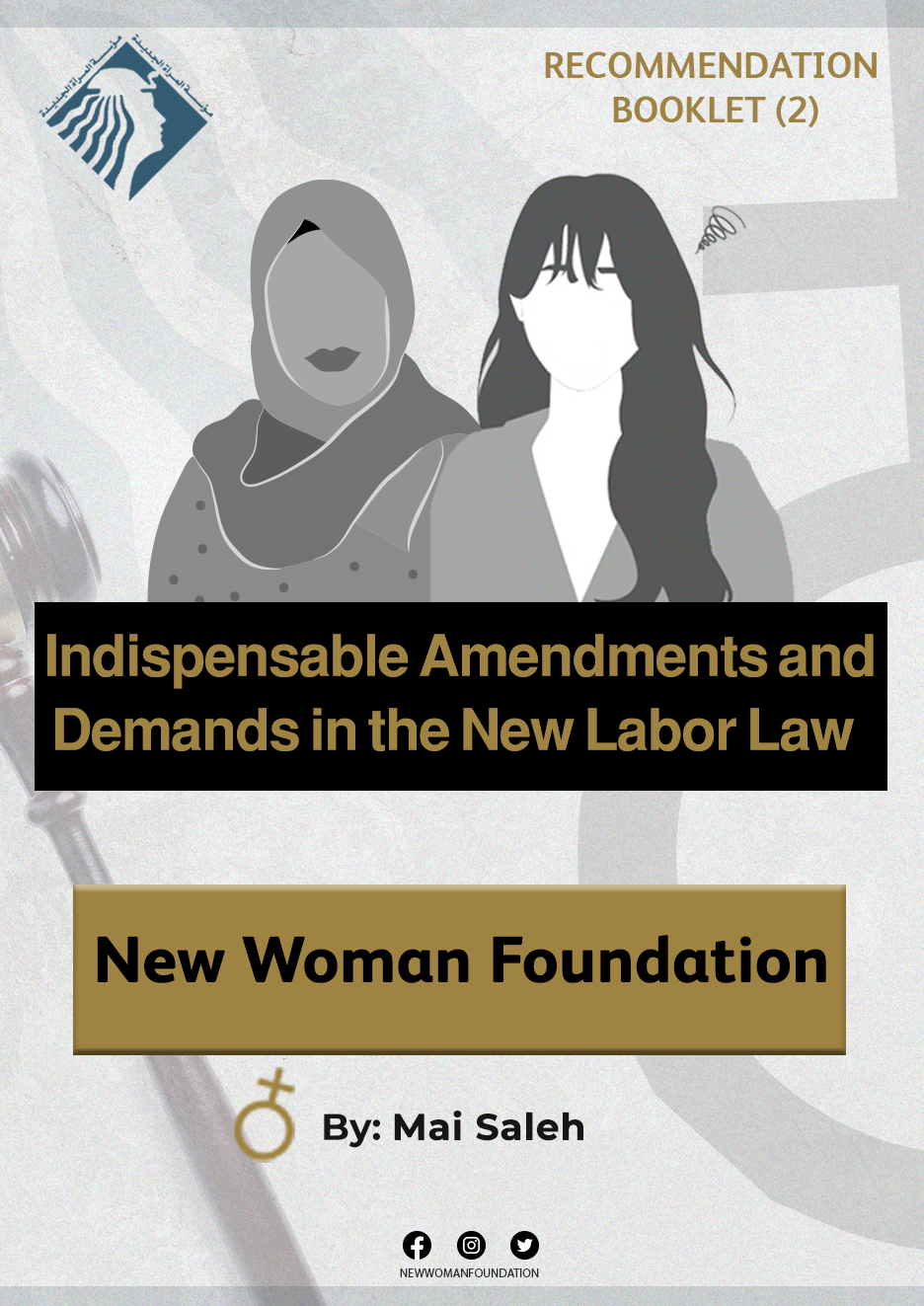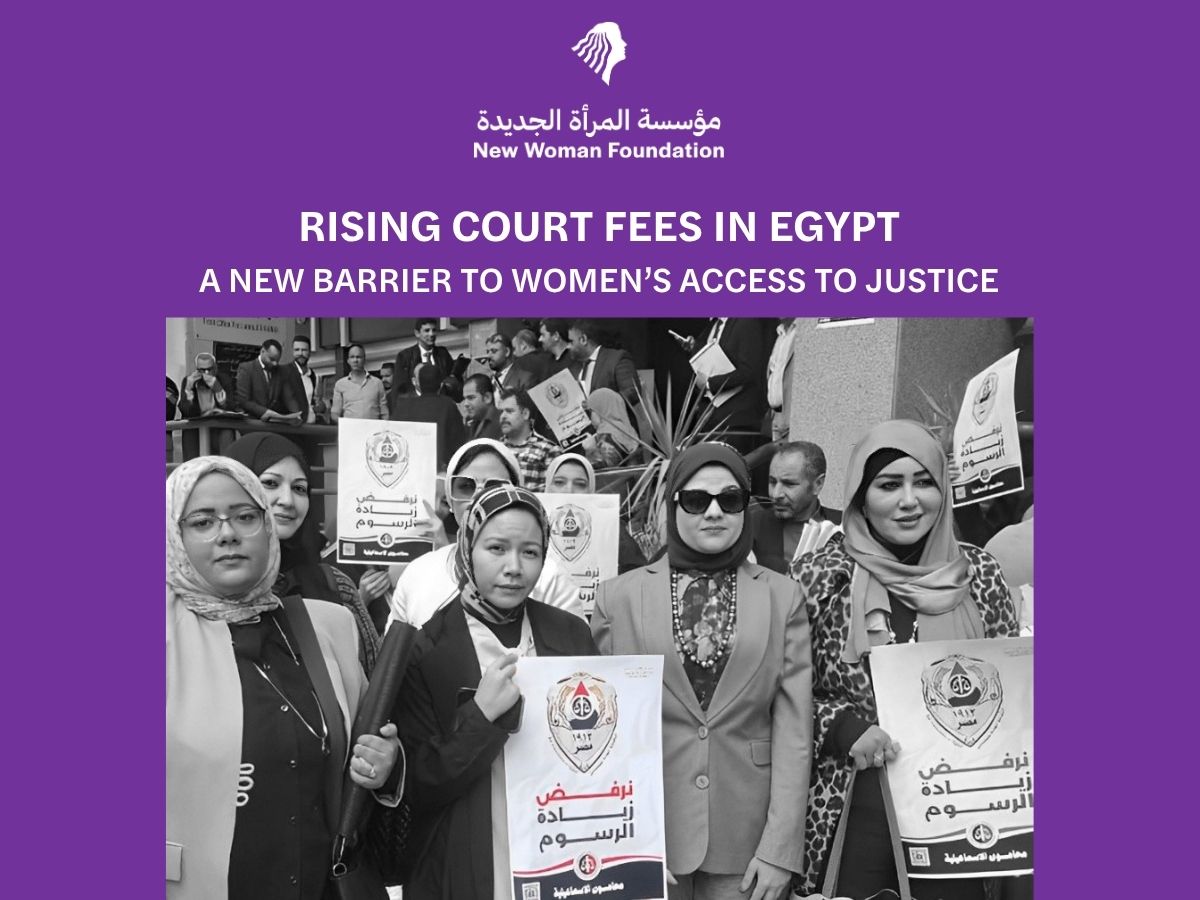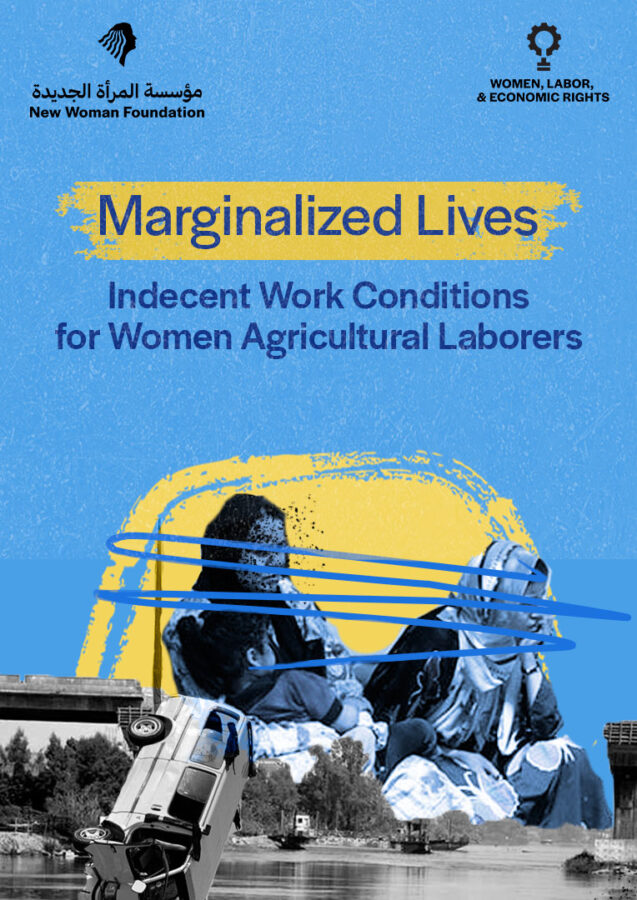- Contact Us
- 0020233382706
- nwrc@nwrcegypt.org
Gender and the new labor code, A traditional vision and dedication to stereotypical roles.
Mai Saleh, New Woman Foundation.
Eight years have passed since the beginning of the discussion and amendments to the Consolidated Labor Laws. After the January revolution, the law amendment became a major demand for unions as well as labor and human rights institutions. The new labor code was considered one of the radical changes and improvements to the economic and social conditions of workers in the private sector. Especially as the gap increased between workers in the public and the private sectors, and also after the promulgation of the act on civil service of 2016.
Over these past years, feminist rights organizations, particularly the New Woman Foundation, submitted a large number of thesis, requirements, and policies addressing the necessity of having a new legislative vision of work relations and rights. This vision should be in line with the gender roles development that seeks gender equality and reduces unemployment rates among women, which amount to 24%. Each new draft raises the spirits and morale of female workers and institutions who care about equitable law in accordance with decent work standards that can improve women’s situations quantitatively and qualitatively in the labor market. Unfortunately, the closer we get to the final draft, which is now being discussed in the senate, we find that it contains many issues. These issues seem to be in the form of new privileges that the law granted to women workers in the private sector, while in fact, it rededicates the stereotypical roles that the current law has addressed since 2003. Moreover, it reduces women’s participation in the labor market, especially after the changes to the labor map and work systems during the pandemic.
Discrimination still exists
Remarkably, the law continues to deprive certain groups of the protective umbrella, ignoring all previous legislative gaps and continuous calls for the amendment of these legal provisions that manifest injustice. For example:
continuing to deprive female workers in agriculture of their reproductive rights, this right is included in the chapter of women’s employment, in a clear and unjustified act of discrimination (not to mention all the other forms of daily discrimination that they are facing in regards to wages as well as resources and property deprivation);
continuing to exclude domestic workers, especially Egyptian workers, by the law despite the demands of various human rights institutions and national councils over the years to include domestic workers in legislative and social protection (this led the International Labor Organization to issue Convention No.189 concerning decent work for domestic workers in 2011).
Although the law stipulates in one of its articles the necessity of equal pay and not discriminating for any reason, the guarantees of protection against violating the article were not always clear and sufficient in this context. This explains the gender gap in wages in the private sector that exceeded 25% due to the patriarchal mentality that still controls employers and the decline in the priorities of women and gender issues within trade-union’s organization programs.
Child laborThe new draft law includes the same inherent weaknesses in the current law, the main one being, allowing child labor and setting rules for it. However, the Convention on the Rights of the Child since 1989 sets the age of childhood at 18 years. The convention assured several core principles including, (the best interest of the child, the need to protect the child from economic exploitation, and the appropriate educational opportunities for the child). These rights are blatantly violated by the law. Keep in mind the absence of children’s ability to organize, negotiate and make decisions in their family or work, which may deprive them of their indigenous rights and make them always the weakest party in these unequal work relations.
Absence of protection against sexual violence
There is no doubt that the latest draft, which is being currently discussed, has some shortcomings, and the most serious one remains the absence of mechanisms, policies, and protection procedures against violence in the workplace. Surprisingly, there is an entire chapter in the Labor Law entitled “Occupational Safety and Health and Securing the Work Environment”. Despite all that, the legislator did not consider that the mechanisms of protection against violence and the provision of a decent and safe working environment for female workers is the core of the work environment. Since the law is concerned with the necessity that entities should provide protection facilities against biological, chemical, and physical risks, it might as well emphasize the need of protection against social and sexual risks. These risks are often occurring due to the failure to take the necessary steps inside the workplace such as (Non-compliance with surveillance cameras, the absence of lighting in some locations, and the lack of safe transportation to and from workplaces). In addition, the absence of complaint and investigation mechanisms and the lack protection of plaintiff and witnesses, which often leads women to leave work. The legislator had to add another task to the tasks of occupational safety and health inspectors to observe and monitor forms of sexual violence against women in accordance with the International Labor Organization Convention (ILO) No. 190 and Recommendation No. 206 attached to it on eliminating violence and harassment in the working world issued in 2019.
Consolidating stereotypical roles for women
One of the most important reasons why trade unions and the media celebrated this particular draft is that it equalized rights Between female workers in the public and the private sector. Especially with regard to reproductive right issues in the women’s employment chapter, which stated the following:
Article 50
A female worker is entitled to four months’ maternity leave, including the period preceding and following childbirth. The period of such leave shall not be less than forty-five days after delivery, provided that she submits a medical certificate indicating the likely date of delivery, and this leave shall be paid. In all circumstances, the female worker is not entitled to such leave for more than three times throughout her service period. The daily working hours of a pregnant woman are reduced by at least an hour, starting from the sixth month of pregnancy, and it is not permissible for her to work overtime during pregnancy until the end of the sixth month after the delivery.
Article 51
Dismissal or termination of the employee during maternity leave (described in the preceding article) is prohibited. The employer may deprive her of compensation for the wages he/she is obligated to pay for the period of the leave or recover such payment if it is proved that she has worked during the leave with third parties, without prejudice to disciplinary accountability.
Article 52
A worker who is nursing her child during the two years following the date of delivery, as well as the prescribed rest period, shall be entitled to two other lactation periods of at least half an hour each, and the worker shall have the right to combine these periods. These two additional periods are calculated from working hours, and there is no reduction in wages.
Article 53
Subject to article 72, paragraph 2, of the Children’s Act promulgated by Act No. 12 of 1996, an employee of an entity that employs 50 or more workers shall be entitled to leave without pay for a period not exceeding two years in order to care for her child. She shall not be entitled to such leave more than three times for the duration of her service.
Article 54
An employee may terminate an employment contract on account of her marriage, pregnancy, or childbirth, and shall notify the employer in writing of her wish within three months of the conclusion of the marriage contract, the proof of pregnancy, or the date of delivery as the case may be. Taking into consideration, this shall not affect the rights established for her in accordance with the provisions of this act or the provisions of the Social Insurance Act.
Article 55
If the employer employs five or more female workers, he/she must post in the workplace, or the workers’ gathering places a copy of the women’s employment system.
Article 56
An employer who employs 100 or more female workers in one entity must establish a nursery or entrust a nursery to care for female workers’ children under the terms and conditions determined by the specialized minister decision.
Entities that are located in one area, and each includes less than 100 workers are committed to participating in the implementation of the obligation set out in the preceding paragraph, under the terms and conditions determined by the specialized minister decision.
These earlier legal provisions (although they seem to be a positive step) require a more comprehensive view from the legislator. Thus, its implementation requires different mechanisms and perspectives on the law. Also, The provisions need to emphasize that the reproductive role is a societal task, and women should not pay for it by depriving them of work. So, the new amendments can be brought into line with the practical reality as it’s well known that the government stopped new public appointments since 2004. Therefore, appointments are limited to the private sector, which unfortunately has always considered the reproductive rights guaranteed to women under international law and instruments as a letter of recommendation to terminate women or to refuse to employ them once they are married or pregnant.
Employers usually do not adhere to some legal provisions, such as the right of establishing a nursery that has been defended and demanded by the New Woman Foundation and many members of women’s unions in the republic. The absence and weakness of penalties for law violations is mainly what motivated private sector entities to not commit with this obligation.
Adding the following sentence “to help women reconcile their work with their family responsibilities” in formulating laws and government decisions is an affirmation of the stereotypical roles of women in the absence of a fair division of roles within the family and society. Based on these inputs, we hope that the amendments to the law will be reformulated to ensure that they are implemented in the direction of gender equality.
Full Demands Here:




